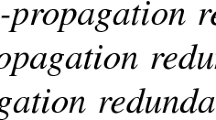Abstract
Given an LTL formula φ in negation normal form, it can be strengthened by replacing some of its literals with false. Given such a formula and a model M that satisfies it, vacuity and mutual vacuity attempt to find one or a maximal set of literals, respectively, with which φ can be strengthened while still being satisfied by M. We study the problem of finding the strongest LTL formula that satisfies M and is in the Boolean closure of strengthened versions of φ as defined above. This formula is stronger or equally strong to any formula that can be obtained by vacuity and mutual vacuity. We present our algorithms in the framework of lattice automata.








Similar content being viewed by others
Notes
The formula vac(M,φ) was already introduced in [13] in the context of CTL formulas.
That is, C φ is a surjective function from the paths of M to the disjuncts of Φ(M,φ).
This example demonstrates the difference between formulas in which each subformula occurs only once and formulas in which subformulas can occur more than once but we treat each occurrence separately. We thank Orna Kupferman for bringing this difference to our attention.
References
Beaty D, Bryant R (1994) Formally verifying a microprocessor using a simulation methodology. In: Proc of DAC’94, pp 596–602
Beer I, Ben-David S, Eisner C, Rodeh Y (2001) Efficient detection of vacuity in temporal model checking. Form Methods Syst Des 18(2):141–162
Birkhoff G (1967) Lattice theory, 3rd edn. AMS, Providence
Chechik M, Devereux B, Easterbrook SM, Gurfinkel A (2003) Multi-valued symbolic model-checking. ACM Trans Softw Eng Methodol 12(4):371–408
Chechik M, Devereux B, Gurfinkel A (2001) Model-checking infinite state-space systems with fine-grained abstractions using SPIN. In: Proc of SPIN’01. LNCS, vol 2057. Springer, Berlin, pp 16–36
Clarke EM, Emerson EA (1981) Design and synthesis of synchronization skeletons using branching time temporal logic. In: Proc of workshop on logic of programs. LNCS, vol 131. Springer, Berlin, pp 52–71
Clarke EM, Grumberg O, McMillan KL, Zhao X (1995) Efficient generation of counterexamples and witnesses in symbolic model checking. In: Proc of DAC’95, pp 427–432
Chockler H, Gurfinkel A, Strichman O (2008) Beyond vacuity: towards the strongest passing formula. In: Proc 12th intl conference on formal methods in computer-aided design (FMCAD’08). Springer, Berlin, pp 188–195
Chockler H, Strichman O (2007) Easier and more informative vacuity checks. In: Proc of MEMOCODE’07. IEEE Press, New York, pp 189–198
Davey BA, Priestley HA (2002) Introduction to lattices and order. Cambridge University Press, Cambridge
Fisman D, Kupferman O, Sheinvald S, Vardi MV (2009) A framework for inherent vacuity. In: Proceedings of 4th Haifa verification conference. LNCS, vol 5394. Springer, Berlin, pp 7–22
Gurfinkel A, Chechik M (2003) Generating counterexamples for multi-valued model-checking. In: Proc of FM’03, pp 503–521
Gurfinkel A, Chechik M (2004) How vacuous is vacuous? In: Proc of TACAS’04. LNCS, vol 2988, pp 451–466
Kupferman O, Lustig Y (2007) Lattice automata. In: Proc of VMCAI’07. LNCS, vol 4349, pp 199–213
Kupferman O (2006) Sanity checks in formal verification. In: Proc of CONCUR’06. LNCS, vol 4137, pp 37–51
Kupferman O, Vardi MY (2003) Vacuity detection in temporal model checking. Int J Softw Tools Technol Transf 4(2):224–233
Lichtenstein O, Pnueli A (1985) Checking that finite state concurrent programs satisfy their linear specification. In: Proc POPL’85, pp 97–107
Namjoshi KS (2004) An efficiently checkable, proof-based formulation of vacuity in model checking. In: Proc of CAV. LNCS. Springer, Berlin, pp 57–69
Purandare M, Somenzi F (2002) Vacuum cleaning ctl formulae. In: Proc 14th conference on computer aided verification. LNCS. Springer, Berlin
Queille JP, Sifakis J (1982) Specification and verification of concurrent systems in CESAR. In: Proc of 5th int symp on programming. LNCS, vol 137, pp 337–351
Samer M, Veith H (2004) Parameterized vacuity. In: Proc 8th intl conference on formal methods in computer-aided design (FMCAD’04). LNCS, vol 3312, pp 322–336
Author information
Authors and Affiliations
Corresponding author
Rights and permissions
About this article
Cite this article
Chockler, H., Gurfinkel, A. & Strichman, O. Beyond vacuity: towards the strongest passing formula. Form Methods Syst Des 43, 552–571 (2013). https://doi.org/10.1007/s10703-013-0192-6
Published:
Issue Date:
DOI: https://doi.org/10.1007/s10703-013-0192-6



